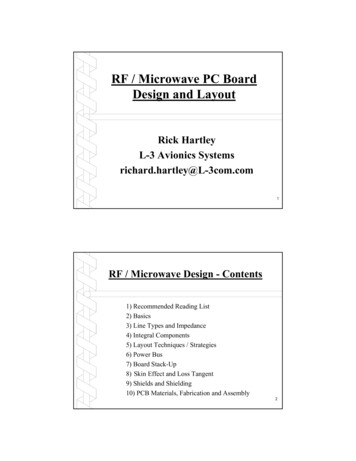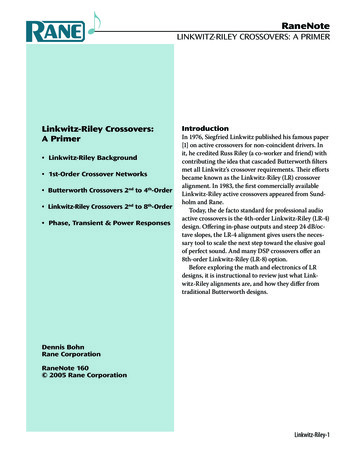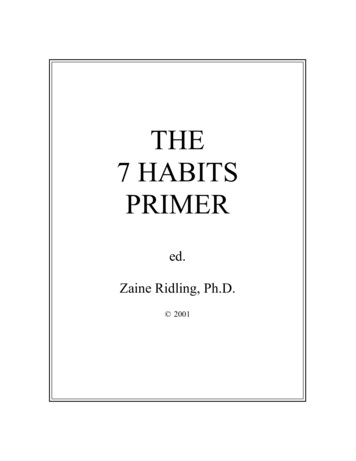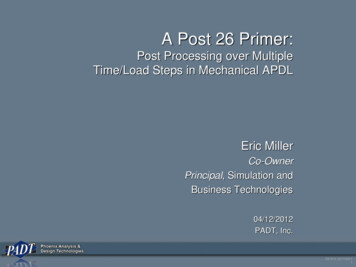
Transcription
BALUNBASICSPRIMERA Tutorial on Baluns,Balun Transformers, Magic-Ts,and 180 HybridsBy: Doug Jorgesen and Christopher Marki
INTRODUCTIONThe balun has a long and illustrious history, first documented in the literature as a device to feed the television transmittingantenna for the Empire State Building1 in 1939. Since then designs have evolved dramatically, and applications have evolvedbeyond driving differential antennas to include balanced mixers, amplifiers, and signaling lines of all types. Baluns have longbeen ubiquitous in low frequency audio, video, and antenna driving applications. The need for high speed, low noise datatransfer has driven the advancement of the balun to higher frequencies and superior performance.Despite these advancements, information about baluns remains scattered and confusing; this application note seeks to resolvethis problem by clarifying the basic characteristics of baluns. First we will define what a balun is, what it does, and how it isdifferent from other components. Next we will define generic balun specs, which we then use to discuss the different typesof baluns and their properties. Finally we will discuss the applications of baluns and how to determine what kind of balun isrequired for several different purposes.I. WHAT IS A BALUN?A balun is any three port device with a matched input and differential outputs. It is most succinctly described by the required(ideal) S-parameters:S12 - S13 S21 - S31S11 - Note what is implied by this: A balun is a three port power splitter, similar to a Wilkinson or resistive power divider. The two outputs will be equal and opposite.- In frequency domain this means the outputs have a 180 phase shift.- In time domain this means the voltage of one balanced output is the negative of the other balanced output. The unbalanced input is matched to the input transmission line impedance (usually 50 Ω). Unlike an isolator or circulator, a balun is a reciprocal device that can be used bidirectionally.2 2014 Marki Microwave, Inc. 215 Vineyard Court Morgan Hill, CA 95037P 408.778.4200 F 408.778.4300 support@markimicrowave.comwww.markimicrowave.com
Digital DataSingle FrequencyDigital le Ended/CommonSingle FrequencyVunbalancedPositive/0 /Non-invertedBalanced/DifferentialNegative /180 /Inverted𝐼𝑚𝑝𝑒𝑑𝑎𝑛𝑐𝑒 𝑅𝑎𝑡𝑖𝑜𝑍 𝑢𝑛𝑏𝑎𝑙𝑎𝑛𝑐𝑒𝑑 𝑍 𝑏𝑎𝑙𝑎𝑛𝑐𝑒𝑑 𝑇𝑢𝑟𝑛𝑠 𝑅𝑎𝑡𝑖𝑜 lancedDigital DataSingle FrequencyFig. 1: Baluns convert between unbalanced and balanced signalsAlso note what is not implied by this: The two outputs are not necessarily matched. The outputs of the balun may or may not be the same impedance as the input. There is no constraint on S23, so the outputs may or may not have isolation. Therefore there may be a different return loss on the outputs for differential and common mode signals.The term balun is a portmanteau of balanced and unbalanced, indicating that a balun will transition between a balanced(also called ‘differential’) transmission line (where opposite currents both travel in transmission lines) and an unbalanced (alsocalled ‘single ended’) transmission line (where the return current travels in the ground). However, this description obscuresthe simplicity of the balun. A balun has equal power outputs just like a Wilkinson power divider, resistive power divider, orquadrature hybrid coupler. However, it has a 180 phase difference between outputs, while the power dividers have 0 phasedifference and quad hybrids have 90 phase difference.At low frequencies, the terms balun and transformer are often used interchangeably because low frequency baluns are almostalways implemented using flux coupled transformers. For this reason it is often said that a balun is a type of transformer, butit is more accurate to say that a transformer can sometimes be used to implement a balun. Many other structures can also beused to implement balun functionality, as we will discuss in section IV. Before discussing the virtues of different types of balunstructures, we need to define what performance specs are important for baluns. 2014 Marki Microwave, Inc. 215 Vineyard Court Morgan Hill, CA 95037P 408.778.4200 F 408.778.4300 support@markimicrowave.comwww.markimicrowave.com3
II. BALUN PERFORMANCE SPECSFrequency coverage: As with all RF/microwave circuits, each performance metric is only valid across some specifiedbandwidth. Increasing the bandwidth from octave, to decade, to multi-decade without sacrificing performance is a majorchallenge. In general Marki baluns can be divided into two types. Those with magnetic coupling perform below 10 MHz,while those with only capacitive coupling have low end performance limited to about 1 GHz, but can operate up to millimeterwave frequencies.Phase Balance: The most important performance criterion is how close the balanced outputs are to having equal power and 180 phase, called balance. Phase balance is the measure of how closely the inverted output is to 180 out of phase with the non-invertedoutput, usually given in degrees. It is the most critical parameter for many balun applications. In addition to the quality of the balunstructure, how closely matched the lengths of the output lines are determines the balance. Typical phase balance for standardmicrowave baluns is 15 max and 10 typical, while high performance Marki baluns approach 5 max and 2 typical.Amplitude Balance: Related to phase balance, amplitude balance is also determined by construction and line matching.Although it is called amplitude balance, it is usually specified in dB and actually gives the match between output powermagnitude. Low performance baluns have amplitude balance of 1.5 dB max and 1 dB typical, while Marki productsapproach .5 dB max and .2 dB typical.Common Mode Rejection Ratio: If two identical signals with identical phase are injected into the balanced ports of the balun(called ‘common mode’ or ‘even mode’ signals), they will be either reflected or absorbed. The amount of attenuation this signalwill experience from the balanced to unbalanced port is called common mode rejection ratio (CMRR) and is expressed in dB. Itis determined by the vectorial addition of the two signals, and therefore is dependent on the amplitude and phase balance ofthe balun. The relationship between amplitude balance, phaseCommon Mode Rejection Ratio (dB)balance, and CMRR is shown in Fig. 2. As a rule of thumb, a 0.114 15dB improvement in amplitude balance will improve the CMRRA low performance balun will have 15-20 dB of CMRR, whileMarki baluns can achieve 25-55 dB of CMRR.12Phase Balance (degrees)by the same amount as a 1 improvement in phase balance. 15 2010 258 19 306 234 35 272 400.511.5Amplitude Balance (dB)2Fig. 2 Common Mode Rejection Ratio (in dB) as afunction of amplitude and phase balance4 2014 Marki Microwave, Inc. 215 Vineyard Court Morgan Hill, CA 95037P 408.778.4200 F 408.778.4300 support@markimicrowave.comwww.markimicrowave.com
Impedance Ratio/Turns Ratio: While the unbalanced impedance of a balun is matched to the input transmission line, the balancedimpedance can be any value. The ratio of the unbalanced impedance to the balanced impedance is the impedance ratio, and isusually stated as 1:n (i.e. 1:1, 1:2, 1:4). Note that the differential impedance is between the balanced signal lines. This is twice theimpedance between the signals and ground. A related value is the turns ratio, which for a flux coupled balun transformer is theratio of primary windings to secondary windings. The impedance ratio is the square of the turns ratio (i.e. a 1:2 turn ratio gives a 1:4impedance ratio). A higher output impedance will provide increased voltage at a reduced current, which is desireable for matchinginto high impedance semiconductor devices. High impedance ratio baluns are easy to design using flux coupled transformers, butmuch more difficult for transmission line transformers and other high frequency constructions.Insertion and Return Loss: A lower insertion loss and higher return loss will mean more power available for downstream functions,an improved dynamic range, and less distortion of signals in previous stages of the system. In a balun without isolation, as in areactive splitter, the return loss of balanced ports will be different for common mode and differential mode signals. In an ideal balunwithout isolation, the common mode signal would be perfectly reflected, with a return loss of 0 dB, while the differential signalwould pass through completely with a return loss of - . To properly characterize this effect one can use mixed-mode S-Parametersinstead of standard S parameters to determine how the device will operate with differential inputs2.Balanced Port Isolation: Usually referred to simply as isolation, this has the same meaning as in other power dividers andcouplers, namely the insertion loss from one balanced port to the other in dB. Most baluns do not offer high isolation becausethe even mode is reflected instead of being properly terminated with a resistive load. The exception is 180 hybrid circuits,where the even mode is output to a port that can be resistively terminated.DC/Ground Isolation: Different from the balanced port isolation, DC isolation is whether the unbalanced port has a DCconnection to one of the balanced ports. Ground isolation is whether there is a connection between the unbalanced groundand the balanced signals or grounds.Group Delay Flatness: For data transmission applications, a flat group delay will ensure a minimal amount of distortion.Group delay flatness is the difference from the average delay across frequencies. This parameter can most easily be evaluatedby either measuring directly on a VNA or examining the output eye diagrams from an input amplitude shift keyed signal.Unwanted group delay ripple is related to poor broadband matching. Baluns with superior return loss will have superior groupdelay flatness. 2014 Marki Microwave, Inc. 215 Vineyard Court Morgan Hill, CA 95037P 408.778.4200 F 408.778.4300 support@markimicrowave.comwww.markimicrowave.com5
III. TYPES OF BALUNSThe most common type of balun by volume is the flux coupled balun transformer. This is a balun created by winding two separatewires around a magnetic core (the same as any transformer), and grounding one side of the primary winding. This creates anunbalanced condition on the primary side, and a balanced condition on the secondary side. In addition, the secondary side canhave an arbitrary ratio of turns to the primary side, creating an arbitrary impedance ratio (the theory of a transformer is explained inmany introductory electrical engineering texts).Magnetic alancedOutputcFig. 3 Construction of a) a flux coupled balun transformer using two wires wrapped around a common magnetic core,b) a transmission line balun consisting of a bifilar coil of two wires wound around each other, with one end connected to ground,and c) a transmission line balun using magnetic core for additional low frequency couplingThe flux coupled balun transformer will induce an AC voltage in the secondary of n times the voltage in the primary, while thecurrent will be n times smaller than in the primary, giving an output impedance of n2 as stated above, where n is the ratio of turns inthe secondary to turns in the primary. The circuit symbols typically used for a balun transformer are shown in Fig. 4. Circuit diagramstypically use a dot convention to indicate which side corresponds to the input polarity. Wire wound flux coupled transformers willoften have a center tap in the secondary winding. In the middle of the secondary winding a virtual ground exists, and connectingthis point to the ground of the secondary system can improve the balance of the output. Center TapUnbalancedBalancedFig. 4 Circuit symbol for a flux coupled baluntransformer, showing the dot convention and center tap6 2014 Marki Microwave, Inc. 215 Vineyard Court Morgan Hill, CA 95037P 408.778.4200 F 408.778.4300 support@markimicrowave.comwww.markimicrowave.com
Ideally, a flux coupled transformer could be used whenever balun functionality is required. It is well understood, relatively simpleto build, provides an arbitrary impedance ratio than can be easily tuned, and provides both DC and ground isolation. Unfortunatelythey are generally limited to frequencies below 1 GHz. At higher frequencies the dipoles in the magnetic material cannot switchfast enough, and the balun loses coupling. The parasitic capacitance between wires causes high frequency signals to travel directlyto ground without coupling through the magnetic material. Magnetic materials also always possess a large loss tangent, leading tohigh signal losses at microwave frequencies.Because of these difficulties, the capacitively coupled transmission line balun was developed. This is a set of coupled lines with oneend grounded, such that the coupling will induce equal and opposite signals in both lines. Converting the ground to a transmissionline allows the signal to be used differentially. This can be done in many ways, most often with a bifilar transmission line wrappedaround a magnetic core to take advantage of the low frequency magnetic coupling as well as the high frequency capacitive coupling(Fig.3c). This basic structure can be connected in many different ways; the more common forms include the 1:4 impedance ratioRuthroff balun and 1:4 Guanella balun3. - - -Fig. 5 Circuit diagram of a 1:1 transmission line balun (left),1:4 Guanella balun (center), and one type of 1:4 Ruthroff balun (right)This functionality can also be performed with a microstrip transmission line wherethe ground plane is simply tapered into a bottom transmission line. This structure,called a tapered balun (also called microstrip-to-balanced stripline balun, Fig. 6),has the advantage of high frequency operation but the disadvantages of no lowfrequency capability and a difficult-to-implement geometry. The tapered balun, inturn, is very similar to other type of coupled line baluns such as the Marchand balun(Fig. 7), coplanar waveguide balun, coaxial balun, planar transformer (spiral) balun,and many other types of coupled line circuits that can be used as baluns, and will notbe reviewed here.Fig. 6 Tapered microstrip balun 2014 Marki Microwave, Inc. 215 Vineyard Court Morgan Hill, CA 95037P 408.778.4200 F 408.778.4300 support@markimicrowave.comwww.markimicrowave.com7
--Fig. 7 Circuit diagram of a capacitively coupled transmission line balun (left) and basic Marchand Balun (right)These types of baluns are all based on quarter wavelength sections of transmission lines, which means that they need to belonger (and higher loss) to operate at lower frequencies. This limits the practical low end of the frequency band to around500 MHz to 1 GHz. On low dielectric substrates the parts will be larger (and usually lower loss), while on higher dielectricsubstrates they will be smaller (and higher loss). For example a quarter wavelength section at 1 GHz on a 2.2 dielectricsubstrate will be 2.15” long, therefore the minimum length of a Marchand balun would be 4.3” long. Conversely at 10 GHz,the same balun would be 0.430” long and easily printed using standard fabrication methods.All the previously mentioned baluns are of one type, where coupling of some sort is used to float the ground of an unbalancedtransmission line, creating a balanced transmission line. Another type of balun is one where an in phase power divisionis performed first, and then a 180 phase shift is applied to oneMatchedDelayof the outputs, creating a balanced output. This structure is not tobe confused with the 180 power divider, which is discussedbelow. This phase shift can be narrow band, such as a half wavetransmission line, or a broadband phase shift such as an inverter(Fig. 8). This technique is commonly used to create higher frequencybaluns for test and measurement. A half-wave balun uses aladder of quarter wave transformers combined with half wavetransmission sections to expand the bandwidth of a simple single21PowerDividerfrequency balun. Another method is to use a coupler 90 phase shift3InverterFig. 8 Phase shift balunon one arm and a coupler with a -90 phase shift on the other arm.These baluns can achieve multi-octave bandwidth if they use interdigital Lange couplers.The final type of balun is the 180 power divider, which is a balun with isolation between the outputs. These are implementedusing 180 hybrid junctions (Fig. 9). These are similar in function to 90 hybrid couplers, but they have a phase shift of180 between the non-isolated ports. They have the property that from two inputs, the common or even mode will output fromone port (the Σ or sum port), while the differential or odd mode will appear at a different port (the Σ or difference port). A180 hybrid coupler can be made into a 180 power divider by terminating the sum port with a 50 Ω load. These types ofcircuits suffer from the same quarter wavelength length requirements as capacitively coupled baluns. Common examples of180 hybrid couplers include the rat race coupler, the asymmetric tapered coupled line coupler, and the magic-T (Fig. 10).Interestingly, a Wilkinson power divider is actually a type of 180 hybrid where the sum port is terminated with a lumpedresistor, called the isolation resistor.8 2014 Marki Microwave, Inc. 215 Vineyard Court Morgan Hill, CA 95037P 408.778.4200 F 408.778.4300 support@markimicrowave.comwww.markimicrowave.com
14 PortHybrid Junction234Port 1Port 2Port 3Port nput/2Fig. 10 Rat Race Coupler (left), asymmetric tandemFig. 9 Schematic and I/O table for a 4-port hybrid junctioncoupler (center), and Waveguide Magic-T (right)Balun TypeMax onImpedanceRatiosApplicationsFlux Coupled BalunTransformer106:120Hz –1 GHzFair ExcellentWith center tapArbitraryBalanced Transmission Lines,Differential AntennasWire-woundTransmission Line Balun105:1500 kHz –10 GHzFair ExcellentNo1:1, 1:4Interface to Differential ICs(ADC/DACs)Capacitively CoupledTransmission Line Balun102:1.5 – 65 GHzFair ExcellentNo1:2Balanced Mixers, Push-PullAmplifiers, Signal CombiningPower Divider - InverterBalun106:1200 KHz –65 GHzFairDepends onPower Divider1:2Test InstrumentsHalf Wave Balun 2:1.5-60 GHzGoodNo1:2MixersRat Race Coupler 2:1.5-50 GHzFairYes1:2Mixers, DuplexersAsymmetric TandemCoupler10:1.5-40 GHzFairYes1:2Mixers, Duplexers, Amplifiers,Antenna ArraysWaveguide Magic T 2:11-146 GHzFairYes1:2Mixers, Duplexers, AmplifiersIV. APPLICATIONS OF BALUNSThe most common application of baluns is to interface an unbalanced signal to a balanced transmission line for long distancecommunications. Differential signaling on balanced transmission lines is more immune to noise and crosstalk, can use lowervoltages, and is lower cost than single-ended signaling on coaxial cables. Hence, it is used for most common intermediateand long distance transmission lines such as RS-422, RS-485, Ethernet over twisted pair, PCI Express, DisplayPort, HDMI,and USB. Therefore, baluns are used to interface local video, audio, and digital signals to long distance transmission lines. Inthese applications the most important characteristic is common mode rejection ratio. The second most important application ofbaluns is for driving differential antennas. There is an abundance of literature from amateur ham radio operators on techniquesto build and operate baluns for various antenna patterns to maximize the antenna gain4. As in differential signaling, therejection of common mode current is the most important metric for an antenna feed balun, although performance also requiresproper impedance ratios and matching to the antenna. 2014 Marki Microwave, Inc. 215 Vineyard Court Morgan Hill, CA 95037P 408.778.4200 F 408.778.4300 support@markimicrowave.comwww.markimicrowave.com9
Another extremely high volume application is the use of baluns to create balanced devices such as push-pull amplifiers andbalanced mixers (Fig. 11). Push-pull amplifiers work by splitting the signal into a positive and negative version with a balun,amplifying them, and then recombining the signals with another balun. One advantage of this scheme is that the saturatedoutput power can be doubled. Alternatively the input power to each amplifier can be reduced by half for a given outputpower, significantly reducing the distortion products created by higher input powers. Another benefit is that this scheme willdramatically reduce, by the baluns’ CMRR, the second order distortion outputs of the amplifier. The second order and all othereven order distortion products will be identical in both amplifiers, while the fundamental will be out of phase. Therefore alleven order products will be canceled in the output balun, while the odd order products pass through.It is this even product cancellation that can be used todramatically reduce spurious products in balanced mixers likeLOthe double balanced mixer shown in Fig. 11. In this structurenot only are the even order distortion products of both theIFRF and LO canceled out, but also the fundamental of the LOwill be canceled out traveling to the RF and IF ports. MarkiMicrowave has been using this technique to design the world’sbest mixers for many decades. Owing to our vast experiencedesigning baluns for mixer applications, Marki MicrowaveRFFig. 11 Push-Pull Amplifier (left) andDouble Balanced Mixer (right)can now offer discrete baluns to meet the most demanding requirements.Marki offers high performance connectorized and surface mount baluns. Our connectorized baluns are typically used forinterfacing high speed differential chips to unbalanced signals, either from test equipment or receivers, for testing purposes.These units allow single ended test equipment such as synthesizers, oscilloscopes, power meters, and network analyzers tointerface with differential devices such as cables, differential amplifiers, receivers, and transmitters. This is very important fordifferential devices, since they will generally behave quite differently when excited with a differential signal vs. when they areexcited with a single ended signal (which can be decomposed into both differential and common mode signals). In particular,a 2 port VNA can be used to measure differential devices with a matched set of baluns, but special care must be taken to deembed the baluns if they do not have isolation5.Our broadband, high performance surface mount baluns are most frequently used as the interface between high speed digitalconverters and heterodyne transmission systems. In this circumstance designers are replacing what was previously the final IFtransmission stage for these heterodyne converters. In this application the most important spec for the balun is the phase balance.An improvement from 12 degrees of phase balance to 3 degrees of phase balance can improve the even order dynamic range ofthe ADC by more than 10 dB6.Matching a wideband analog to digital converter (ADC) to a single ended source is a difficult challenge, especially whenusing super-Nyquist sampling (at frequencies above the fundamental Nyquist zone). A differential amplifier at the front end willadd noise and degrade linearity, while a balun will provide voltage gain without adding noise (an ADC responds to voltage,10 2014 Marki Microwave, Inc. 215 Vineyard Court Morgan Hill, CA 95037P 408.778.4200 F 408.778.4300 support@markimicrowave.comwww.markimicrowave.com
which will be 2 higher or more depending onBALUN100 nFADC15Ωthe impedance ratio at the differential outputs of a150Ωbalun). The input impedance of an ADC is typically 1kΩmuch higher than 50Ω, generally in the kΩ range.150ΩThis means that a higher output impedance balunwill generally match better to an ADC input than a100 nF1:1 balun.100 nF 2pF15ΩFig. 12 ADC Matching Circuit using a Balun7An example ADC matching circuit is shown in Fig. 12.It involves AC coupling capacitors, parallel resistors, and inductance to match the capacitive, high impedance ADC load to thetransmission line input. It also includes series resistors to limit any amount of charge injection coming from the ADC’s internalsampling structure back into the analog system. Due to the band-limiting nature of the ADC, it is often necessary to use a balun thatis much wider band in a pure 50 Ω system than the required system bandwidth.SUMMARYBecause the term ‘balun’ encompasses a wide range of devices and applications, the information on them is scattered and confusing.In this application note we have clarified that baluns are differential power dividers. They can be built as transformers, capacitivelyand/or magnetically coupled transmission lines, hybrid couplers, or as a combination of a power divider and an inverter. Theirmost important characteristic is how well balanced they are in power, and how close to 180 out of phase their balanced ports are.Baluns can be used for many applications to transition between single ended and differential signals and to cancel common modenoise and signals. The future of baluns lies in further improving the balance, increasing the power handling, and reducing the size,complexity, and cost in these critical communications applications.FOOTNOTES1 N.E. Lindenblad, “Television transmitting antenna for EmpireState Building,” RCA Rev., vol. 3, pp. 387-408, April 1939.2 Bockelman, D.E., Eisenstadt, W.R., ”Combined differential andcommon-mode scattering parameters: theory and simulation”,Microwave Theory and Techniques, vol. 43, no. 7, 1995, pp.1530-1539.3 Gustav Guanella (1909-1982) was a brilliant Swiss inventorand manager with over 200 patents. He developed the basictransmission line balun, and the one that bears his name, tomatch a high impedance power amplifier to a low impedanceantenna. His sister married Albert Hoffman, inventor of LSD.Clyde Ruthroff was a scientist at Bell Labs from 1946-1977.In his paper, ‘Some Broad-Band Transformers’, he actuallyproposes 9 different transformers that became the basis ofhundreds of variations. We show only one here.4 Most important is Jerry Sevick, who was drafted by the ChicagoBears, but instead spent his career working on antennas at BellLabs. He also coined the term ‘unun’ to describe an unbalancedto unbalanced impedance transformer. See Jerry Sevick,W2FMI, Understanding, Building, and Using Baluns andUnuns, CQ Communications, 2003.5 For more information see “The Problem with Back to BackBaluns”, Marki Microwave Tech Notes, blem-with-back-toback-baluns/6 For more information see “Why buy a high quality balun/transformer for an analog to digital converter (ADC)?”, MarkiMicrowave Tech Notes, igital-converter-adc/7 See Rob Reeder, “Wideband A/D Converter Front-EndDesign Considerations: When to Use a Double pdf 2014 Marki Microwave, Inc. 215 Vineyard Court Morgan Hill, CA 95037P 408.778.4200 F 408.778.4300 support@markimicrowave.comwww.markimicrowave.com11
2014 Marki Microwave, Inc. 215 Vineyard Court Morgan Hill, CA 95037P 408.778.4200 F 408.778.4300 support@markimicrowave.comwww.markimicrowave.com
The flux coupled balun transformer will induce an AC voltage in the secondary of n times the voltage in the primary, while the current will be n times smaller than in the primary, giving an output im











